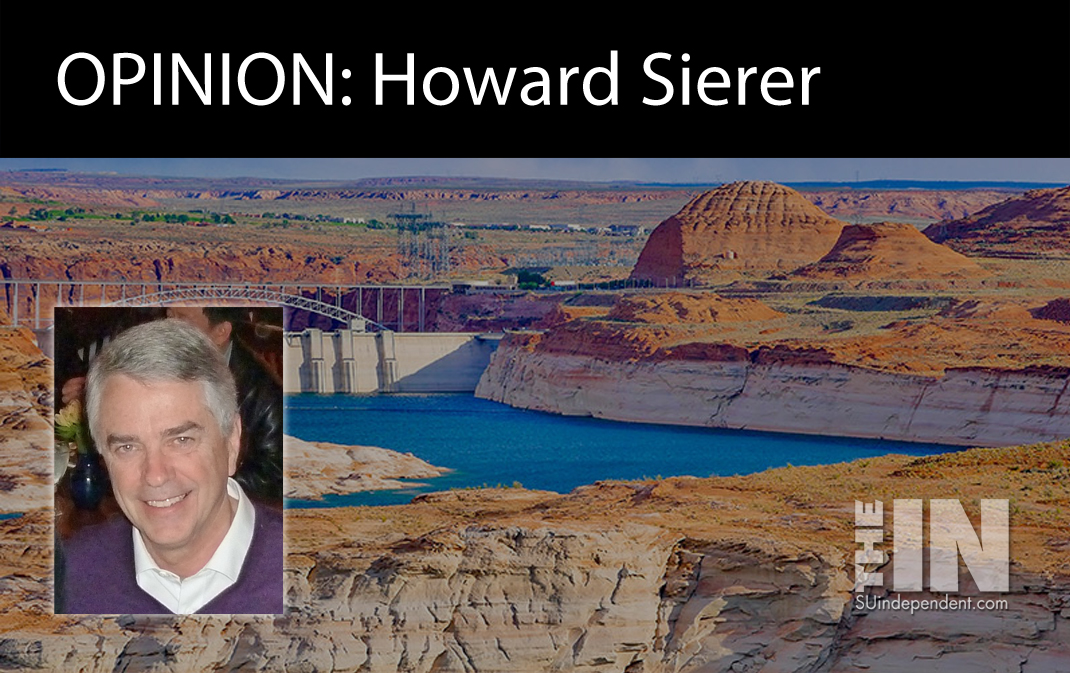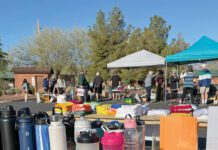
The End of the Lake Powell Pipedream
– By Howard Sierer –
It’s time to recognize that Southern Utah is in the Mojave Desert, not on the Wasatch Front. Proposing to construct the Lake Powell Pipedream in the midst of a 20-year megadrought is madness.
The federal government has declared the first-ever Colorado River water shortage. Lake Mead is 35% full, the lowest it’s been since Hoover Dam was constructed in the 1930s. Closer to home in Southern Utah, Lake Powell is also at its record low, 32% full.
Both are forecast to drop further in 2022 and as result, water allocations to Arizona farmers will be cut by a third. The Colorado River supplies about 40% of that state’s water. Nevada will also see reductions.
Both the Hoover Dam and the Glen Canyon Dam generate clean electrical power relied upon across the Southwest. Hoover Dam generates enough hydropower to serve 1.3 million people each year in Nevada, Arizona, and California. Less water means less power.
For years, the Glen Canyon Dam has supplied enough electricity to meet the annual needs of as many as 400,000 homes, but Lake Powell’s surface must be at least 3,490 feet above sea level to keep the turbines spinning. As a stopgap in July to help keep its level high enough for power generation, the Bureau of Reclamation for the first time ever released water from reservoirs upstream of Lake Powell.
The bad news: there’s a 3% chance that power generation will be halted in 2022 and a 34% chance that it will happen in 2023.
I’ve opposed the Lake Powell Pipeline because I don’t want to see Washington County turned into a replica of the Los Angeles basin with mile after mile of strip malls and tract housing, destroying the very reasons many of us moved here. I’ve argued that the pipeline’s multi-billion-dollar construction cost would exceed forecasts and would saddle future generations with onerous water rates and property taxes.
Now my arguments have been superseded by our ongoing megadrought. I give due credit to those LPP critics who foresaw the possibility, now the likelihood, that there would be no water available to fill the pipeline. We should be thankful that we didn’t start building it 10 years ago as originally proposed.
We can continue to enjoy moderate growth for years without the pipeline if our Washington County Water Conservation District gets serious about water conservation instead of just paying it lip service.
To start, we use way too much water on our outdoor landscaping: per the WCWCD, about 60% of residential water use goes for landscape irrigation. I continue to advocate steeply rising water rates for higher volume users, incentivizing but not commanding them to reduce water use without the heavy hand of one-size-fits-all government regulation.
For those with large grass lawns who want to avoid those high rates, a University of Virginia study found that turf removal programs were successful in 63 western counties. For example, water providers in California, Nevada and Arizona offer homeowners $3 per square foot when they replace grass with desert landscaping. Our WCWCD should do the same.
The Southern Nevada Water Authority has replaced grass lawns with desert landscaping. Coupled with other water saving methods, it has reduced its Las Vegas metro area per capita water usage by 47% between 2002 and 2020. Our WCWCD should do the same.
I won’t make any friends among Washington County farmers, ranchers and traditionalists when I say it’s time to stop subsidizing those activities with underpriced water. Alfalfa can be grown far more productively elsewhere. Using precious water for a pioneer-era legacy crop makes little sense, especially when longstanding “use it or lose it” policies encourage widespread waste.
Interestingly, the Walton Family Foundation, funded by the Walmart heirs, has long advocated establishing water markets as a method of allocating the region’s water more efficiently. It has given about $200 million to various environmental groups including The Nature Conservancy, the National Audubon Society, the Environmental Defense Fund and American Rivers to support this idea.
The foundation says that such markets can “secure a regular flow of water back to depleted ecosystems and sell the rest back to irrigators or cities.” The Nature Conservancy explains its support: “We need every tool in the toolbox, including guided water markets, to increase water security and protect the things we all care about.”
Water markets are an intriguing idea but I question whether deep-pocketed investors could “corner the market” in a limited resource to the country’s disadvantage.
Is the Lake Powell Pipedream a dead issue? Let’s hope so.
The WCWCD has been the pipeline’s biggest cheerleader for 20 years. The district’s general manager, Zach Renstrom, said there aren’t other good options. He stated, “Our Plan B is you’ll have to at some point say, ‘Stop. You can’t build any more houses here.’”
My advice to Renstrom is that it’s time to get serious about Plan B.




You’ve nailed it, Howard! We have other options that are much cheaper than the pipeline. The district has challenged the new Local Waters Alternative to the Lake Powell Pipeline 2.0, and the reasons they give are no more believable than their faith that the Colorado River will provide water for the pipeline.
My out of state kids were here and were amazed we don’t have a water conservation plan like Phoenix and even Denver. If you are an even house number you water on even days and if you are an odd number address you water on odd days. No desert community other than st. George would not have a plan for water conservation. We have heard so much about the pipeline we have lost common sense when it comes to saving water. We can certainly do better and not rely on a plan that doesn’t make sense. You are right on. They pipeline is a pipe dream. Let it go.
The very same logic of stopping this mentality of uncontrolled growth needs to prevail in Iron County as well where there’s a plan to pipe water from Beaver County because of over pumping of local sources. With little apparent resistence this water grab isn’t much different from the St George pipeline and the Las Vegas pipeline from Western Utah which was finally abandoned last year.
Cedar City is fast becoming an extension of St George with increased traffic and housing development.
Thoughtful and well-said. This kind of information about water supply and use should be provided to the entire population. I believe we will respond appropriately.